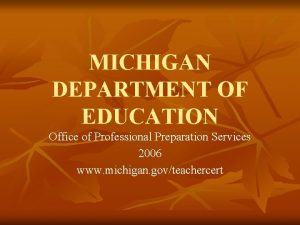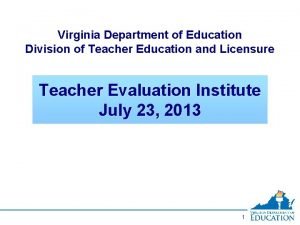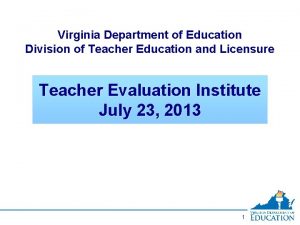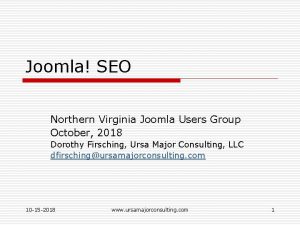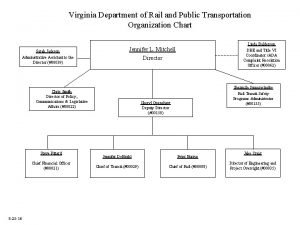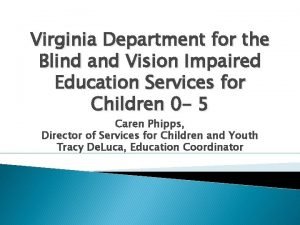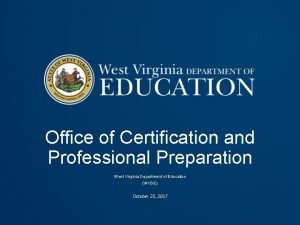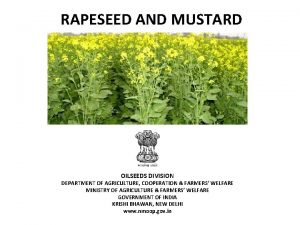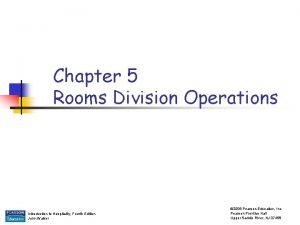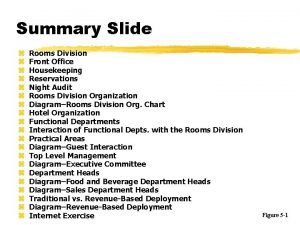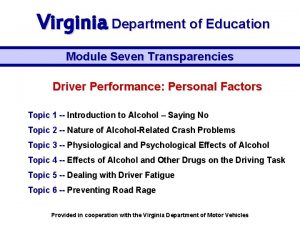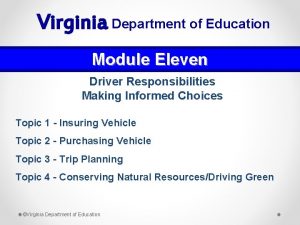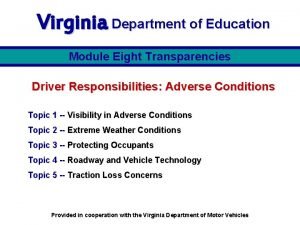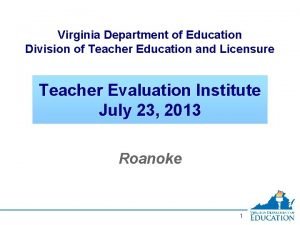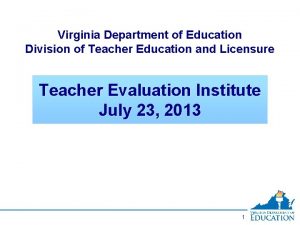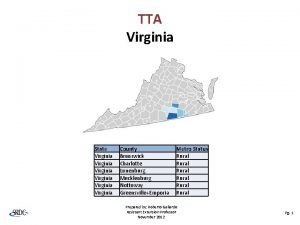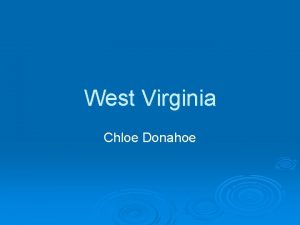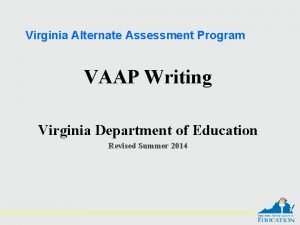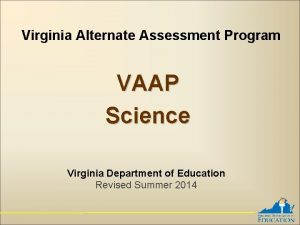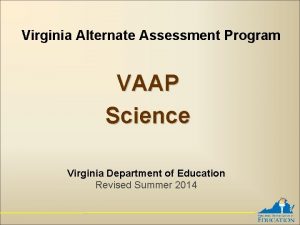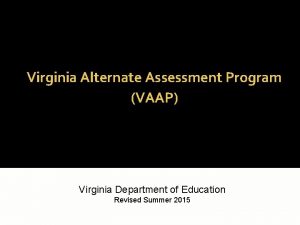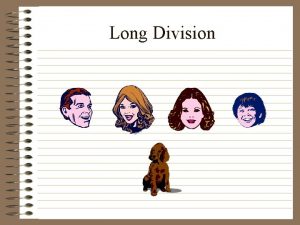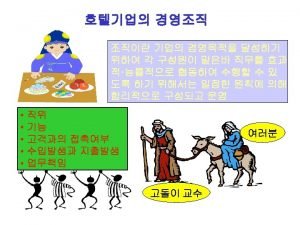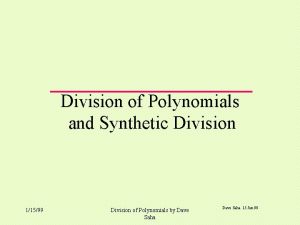Virginia Department of Education Division of Teacher Education

























- Slides: 25

Virginia Department of Education Division of Teacher Education and Licensure Teacher Evaluation Institute July 23, 2013 1

Critiquing Middle School Goals 2

Afternoon Agenda • Critiquing goals using the SMART criteria • Creating goals using the SMART criteria 3

Grade 7 English Teacher Q • Grade 7: Baseline Reading Data • Online reading assessment used • Beginning of the year reading levels Ø 6. 7 and below = Below grade level Ø 6. 8 -7. 2 = On grade level Ø 7. 2 and above = Above grade level 4

Teacher Q: Student Reading Baseline Data Student Baseline Score Student 1 5. 3 Student 2 5. 5 Student 3 5. 5 Student 4 5. 5 Student 5 5. 6 Student 6 5. 7 Student 7 6. 2 Student 8 6. 3 Student 9 6. 6 Student 10 6. 6 Student 11 6. 8 Student 12 6. 8 Student 13 6. 8 Student 14 7. 0 Student 15 7. 2 Student 16 7. 4 Student 17 7. 6 Student 18 7. 7 Student 19 7. 7 Student 20 8. 0 5

Student Baseline Reading Data: Tiers 12 10 10 8 6 5 5 On Grade Level Above Grade Level 4 2 0 Below Grade Level 6

Teacher Q Evaluate: Is this goal SMART? Goal Statement: From September 2012, to June 2013, 100 percent of students will make measurable progress in reading as measured by the online assessment. All students will improve their baseline score by 1. 0 grade levels by the post-assessment. A good Goal statement is one that is… • Specific • Measurable • Appropriate • Realistic, but Rigorous • Time-bound 7

How would you improve this goal? Goal Statement: From September 2012, to June 2013, 100 percent of students will make measurable progress in reading as measured by the online assessment. All students will improve their baseline score by 1. 0 grade levels by the post-assessment. 8

Improved Goal: One Suggestion Goal Statement: From September 2012, to June 2013, 100 percent of students will make measurable progress in reading as measured by the online assessment. • Students scoring below grade level will improve their scores by 1. 5 grade levels. • Students scoring at or above grade level will improve their scores by 1. 0 grade levels. 9

Goals for Students with Disabilities 10

Teacher Q and Special Education Teacher R: Student Baseline Data Student Baseline Score Student 1 5. 3 Student 2 5. 5 Student 3 5. 5 Student 4 5. 5 Student 5 5. 6 Student 6 5. 7 Student 7 6. 2 Student 8 6. 3 Student 9 6. 6 Student 10 6. 6 Student 11 6. 8 Student 12 6. 8 Student 13 6. 8 Student 14 7. 0 Student 15 7. 2 Student 16 7. 4 Student 17 7. 6 Student 18 7. 7 Student 19 7. 7 Student 20 8. 0 Students Identified with Disabilities Teachers Q and R teach using a collaborative model to deliver reading instruction. 11

Goal Setting Considerations for Students with Disabilities • Does the student’s disability affect the student’s ability to reach the goal? • What has been the academic history of the student up to this point? • What types of instructional interventions have been provided to the student in the past? 12

Student 5 Receives services for language arts (writing and reading) and speech Academic History: Reading Grade Baseline Score End-of-Year Score 4 3. 5 4. 1 4. 8 6 4. 7 5. 5 7 5. 6 Discussion Questions: • Based on this data, is the improved goal written by Teacher Q appropriate for this student? • What other factors should be considered in determining an acceptable goal? 13

Student 6 Receives services for language arts (writing and reading) and mathematics Grade Academic History: Reading Baseline Score End-of-Year Score 4 2. 3 4. 0 5. 3 6 5. 4 5. 8 7 5. 7 Discussion Questions: • Based on this data, is the improved goal written by Teacher Q appropriate for this student? • What other factors should be considered in determining an acceptable goal? 14

Student 7 Receives services for mathematics Academic History: Reading Grade Baseline Score End-of-Year Score 4 2. 8 3. 9 5 4. 0 5. 0 6 4. 9 6. 3 7 6. 2 Discussion Questions: • Based on this data, is the improved goal written by Teacher Q appropriate for this student? • What other factors should be considered in determining an acceptable goal? 15

Art Teacher S • • Grade 7: Visual Arts Division-developed visual arts knowledge assessment Ø Visual Communication and Production (10 questions; 7 answered correctly is considered proficient) Ø Cultural Content and Art History (10 questions; 7 answered correctly is considered proficient) Ø Judgment and Criticism (10 questions; 7 answered correctly is considered proficient) Ø Aesthetics (10 questions; 7 answered correctly is considered proficient) 16

Teacher S: Student Baseline Data Student 1 Student 2 Student 3 Student 4 Student 5 Student 6 Student 7 Student 8 Student 9 Student 10 Student 11 Student 12 Student 13 Student 14 Student 15 Student 16 Student 17 Student 18 Student 19 Student 20 Student 21 Student 22 Student 23 AVERAGE Visual Communication and Production Cultural Context and Art History Judgment and Criticism Aesthetics TOTAL QUESTIONS 10 possible 7 = Proficient 40 possible 28 = Proficient 0 0 0 0 1 1 0 0 1 2 0 1 1 0 2 1 1 1 0 3 1 1 2 0 4 0 1 2 1 4 1 2 1 0 4 2 0 1 1 4 1 0 2 1 4 1 2 0 1 4 2 0 1 2 5 2 1 2 0 5 3 2 0 1 6 3 1 0 2 6 2 1 6 3 2 1 0 6 2 2 2 1 7 2 2 2 4 10 3 2 1 5 11 5 6 7 6 24 8 8 9 7 1. 9 1. 6 1. 7 1. 5 17 32 6. 7

Teacher S Goal Critique: Is this goal SMART? Goal Statement: A good Goal statement is one that is… From September 2012, to June 2013, 70 percent of grade 7 students will score “Proficient” or higher on the divisiondeveloped visual arts knowledge assessment. • Specific • Measurable • Appropriate • Realistic, but Rigorous • Time-bound 18

How would you improve this goal? Goal Statement: From September 2012, to June 2013, 70 percent of grade 7 students will score “Proficient” or higher on the division-developed visual arts knowledge assessment. 19

Improved Goal: One Suggestion Goal Statement: From September 2012, to June 2013, students will make measurable progress in visual arts knowledge as measured by the division-developed visual arts assessment. • Students scoring 0 -11 points will improve their scores by 30 points. • Students scoring 12 -24 points will improve their scores by 15 points. • Students scoring above 25 points will improve or maintain their scores by 15 points on the grade 8 division-developed visual arts assessment. 20

Creating Goals 21

Goal Writing Practice • Work with your table. • Choose a content area appropriate for your level. • Choose four areas that can be assessed in that content area. • Review the baseline data. • Write a SMART goal on chart paper. 22

Fill-in-Your-Content-Information Student 1 Student 2 Student 3 Student 4 Student 5 Student 6 Student 7 Student 8 Student 9 Student 10 Student 11 Student 12 Student 13 Student 14 Student 15 Student 16 Student 17 Student 18 Student 19 Student 20 Student 21 Student 22 Student 23 AVERAGE FILL IN CATEGORY 10 possible 0 2 1 1 3 1 0 3 3 2 4 1 2 5 8 4 4 7 7 8 9 3. 5 FILL IN CATEGORY 10 possible 1 0 2 1 4 2 5 2 2 1 3 1 2 6 7 7 5 5 9 9 10 3. 9 FILL IN CATEGORY 10 possible 0 1 2 1 3 1 4 4 2 2 4 5 3 6 4 5 3 4 6 6 5 6 6 8 4 7 9 8 8 9 7 5 5 4 5 8 6 9 7 6 10 9 8 10 10 10 23 5. 8 TOTAL 40 possible 2 5 7 10 11 12 13 14 15 16 16 17 18 19 21 23 24 24 24 25 35 35 39 18. 5

Directions • Trade goals with the other table to which you are assigned. • Evaluate the goal for the SMART criteria. • Provide feedback. • When it’s time to trade back goals, send one person back with the other table’s goal to explain the feedback. • Afterward, rewrite your goal based on the comments. 24

Final Thoughts • 3 important things to keep in mind when setting goals • 2 things that worked well in this training • 1 question you still have 25
 Michigan department of education teacher certification
Michigan department of education teacher certification Teacher education division
Teacher education division Teacher education division
Teacher education division Northern virginia seo
Northern virginia seo Virginia department of agriculture food safety
Virginia department of agriculture food safety Virginia department of historical resources
Virginia department of historical resources Virginia department of rail and public transportation
Virginia department of rail and public transportation Virginia department for the blind and vision impaired
Virginia department for the blind and vision impaired Wvde certification renewal
Wvde certification renewal Mohari botanical name
Mohari botanical name Division of academics department of mathematics
Division of academics department of mathematics Department vs division
Department vs division Imf
Imf Introduction of room division
Introduction of room division Room division department
Room division department Erf for teacher 3
Erf for teacher 3 Good morning teacher
Good morning teacher 369 times 2
369 times 2 F(3)
F(3) 2065 divided by 5
2065 divided by 5 What is synthetic division
What is synthetic division Curriculum guide for driver education in virginia module 10
Curriculum guide for driver education in virginia module 10 Module 7 topic 5-6
Module 7 topic 5-6 Module 11 topic 1 insuring a vehicle
Module 11 topic 1 insuring a vehicle Module 8 topic 1 drivers ed
Module 8 topic 1 drivers ed Curriculum guide for driver education in virginia module 3
Curriculum guide for driver education in virginia module 3
